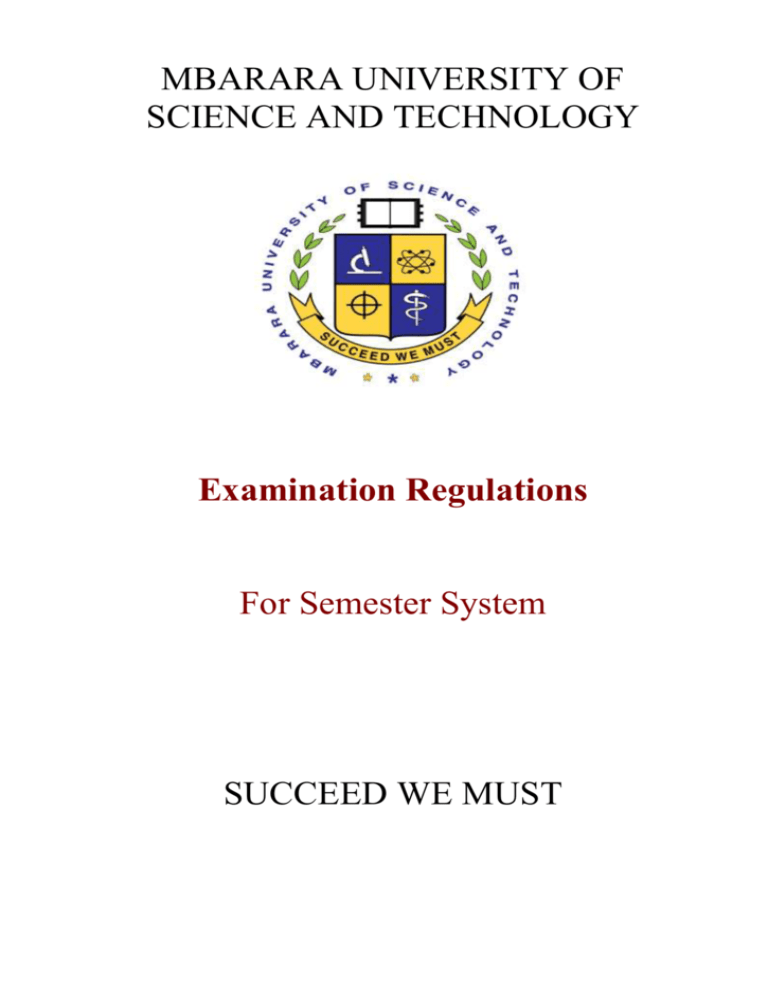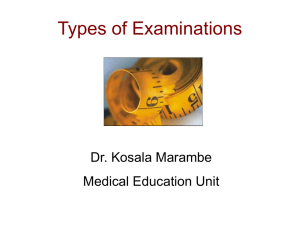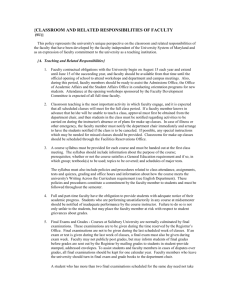MBARARA UNIVERSITY OF SCIENCE AND TECHNOLOGY
advertisement

MBARARA UNIVERSITY OF SCIENCE AND TECHNOLOGY Examination Regulations For Semester System SUCCEED WE MUST FORWARD Mbarara University of Science and Technology introduced the semester system in October 2006 with Bachelor of Business Administration. The following year all other undergraduate programmes offered here started on the system. As a result, the beginning of the academic year, which used to start on the first Monday of October every year, shifted to mid-August. The e-booklet on the examination regulations should be read by both staff and students. The semester system introduces new concepts on how the structure works. The programmes are divided into a number of courses. Each course is awarded a particular credit value and a student works toward achieving the programme graduation load by accumulating credit. Mbarara University regulations differ slightly from other Universities operating the semester system which students and staff should not lose sight of. The variation which has been introduced at Mbarara University relates to failure in course units. A student who fails a course unit(s) is allowed a supplementary examination. A student who fails at a supplementary/special examination is not allowed to go forward with the failed course unit into the next year of study. That student is allowed to repeat the failed course unit(s) when they are next offered, does assignments and sits for the examinations. The interpretation of these regulations rests with Senate. I am duty bound to record the University’s indebtedness to Mr. Simon Anguma, Dean of the Faculty of Science and his team for the excellent work they have done to work out these examination regulations as well as other semester rules which have been endorsed by Senate. SUCCEED WE MUST S B Bazirake ACADEMIC REGISTRAR 2 TABLE OF CONTENTS Page FORWARD ........................................................................................................................... 2 1.0 The Semester System .................................................................................................. 6 1.1 Academic Periods........................................................................................................ 6 1.1.1 Academic year ...................................................................................................... 6 1.1.2 Semester ............................................................................................................... 6 1.1.3 Recess term .......................................................................................................... 6 1.2 Courses ........................................................................................................................ 6 1.2.1 Core courses ......................................................................................................... 6 1.2.2 Elective................................................................................................................. 6 1.2.3 Group of elective courses ..................................................................................... 6 1.2.4 Substitution for a failed elective(s) ...................................................................... 6 1.2.5 Number of elective courses .................................................................................. 6 1.2.6 Ceiling for elective courses .................................................................................. 6 1.3 Pre-requisite ................................................................................................................ 7 1.3.1 Pre-requisite course .............................................................................................. 7 1.4 Audited course ............................................................................................................ 7 1.4.1 Conversion of Audited courses ............................................................................ 7 1.4.2 Audited courses on the transcript ......................................................................... 7 1.5 Content of courses ....................................................................................................... 7 1.6 Size of a course ........................................................................................................... 7 1.6.1 Courses with practical component ....................................................................... 7 1.7 Major ........................................................................................................................... 7 1.7.1 Minor .................................................................................................................... 7 1.7.2 Contact hour ......................................................................................................... 7 1.7.3 Credit or Credit Unit ............................................................................................ 7 1.8 Course Size ................................................................................................................. 7 1.8.1 Smallest course size ............................................................................................. 8 1.8.2 Largest course size ............................................................................................... 8 1.9 Programme .................................................................................................................. 8 1.9.1 Academic programme .......................................................................................... 8 1.9.2 Structure of academic Programmes ..................................................................... 8 1.9.3 Specialization in academic programmes .............................................................. 8 1.10 Academic programme load ....................................................................................... 8 1.10.1 Semester load ..................................................................................................... 8 1.10.2 Normal semester load ......................................................................................... 8 1.10.3 Maximum semester load .................................................................................... 8 1.10.4 Graduation programme load .............................................................................. 8 1.10.5 Maximum durations for the various programmes ................................................. 8 1.11 Course identification system ..................................................................................... 9 1.11.1 The letter codes .................................................................................................. 9 1.11.2 The number codes .............................................................................................. 9 1.11.3 Letter codes for courses in Faculty of Science................................................... 9 1.11.4 Letter codes for courses in Faculty of Medicine ................................................ 9 1.11.5 Letter codes for courses in Faculty of Development Studies ........................... 10 1.11.6 Letter codes for courses in Institute of Computer Science .............................. 10 1.11.7 Interpretation of number codes ........................................................................ 10 1.11.8 The first digit .................................................................................................... 10 1.11.9 The second digit ............................................................................................... 10 1.11.20 The last two digits .......................................................................................... 10 2.0 Examination regulations, assessment, grading, and classifications of awards ......... 10 2.1 Faculty or Institute Board of Examiners ................................................................... 10 2.1.1 Membership of Faculty or Institute Board of Examiners................................... 10 3 2.1.2 Faculty or Institute Board of Examiners Meetings ............................................ 10 2.1.3 Minutes Secretary............................................................................................... 11 2.2 Assessment ................................................................................................................ 11 2.3 Coursework ............................................................................................................... 11 2.3.1 Coursework components .................................................................................... 11 2.3.2 Contribution from coursework to the total mark ............................................... 11 2.3.3 Administration of coursework............................................................................ 11 2.3.4 Coursework scripts ............................................................................................. 11 2.3.5 Publication of coursework marks ....................................................................... 11 2.4 Certificate of due performance.................................................................................. 11 2.4.1 Minimum class attendance required for certificate of due performance............ 11 2.4.2 Coursework requirements for certificate of due performance ........................... 11 2.4.3 Certificate of due performance as a qualification to sit university examinations ..................................................................................................................................... 11 2.4.4 Contents of Certificate of Due Performance ...................................................... 11 2.5 University examinations ........................................................................................... 11 2.5.1 University examinations period ......................................................................... 12 2.5.2 Timetable Committee for university examinations ............................................ 12 2.5.3 Examination timetable ....................................................................................... 12 2.5.4 Publication of examination timetables ............................................................... 12 2.5.5 Administration of examinations outside the approved time table ...................... 12 2.5.6 Reporting time for examinations........................................................................ 12 2.5.7 Examination venues ........................................................................................... 12 2.5.8 ............................................................................................................................. 12 2.5.9 Pass mark ........................................................................................................... 12 2.5.10 Examination Contribution to the total marks ................................................... 12 2.5.11 Contravention of Examination Regulations ..................................................... 12 2.6 Absence from university examinations ..................................................................... 13 2.7 Examination Results ................................................................................................. 13 2.7.1 Submission of examination marks ..................................................................... 13 2.7.2 Approval of examinations results by departments ............................................. 13 2.7.3 The Faculty or Institute Examinations Committee ............................................ 13 2.7.4 Approval of examinations results by the Faculty or Institute Board of Examiners.................................................................................................................... 13 2.7.5 Publication of provisional examinations results ................................................ 14 2.7.6 Publication avenues............................................................................................ 14 2.8 Supplementary examinations .................................................................................... 14 2.8.1 Qualification to sit supplementary examinations ............................................... 14 2.8.2 Supplementary examinations in Clinical courses .............................................. 14 2.8.3 Supplementary Examination season .................................................................. 14 2.8.4 Failure of Supplementary Examinations ............................................................ 14 2.9 Special examinations................................................................................................. 15 3.0 Grades and Classification of Awards ........................................................................ 15 3.1 Progression ................................................................................................................ 15 3.1.1 Normal progression ............................................................................................ 15 3.1.2 Vice Chancellors list .......................................................................................... 15 3.1.3 Dean’s list .......................................................................................................... 15 3.2 Discontinuation ......................................................................................................... 15 3.3 Appeals ...................................................................................................................... 15 3.4 Grading...................................................................................................................... 15 3.4.1 Abbreviations Describing Grades ...................................................................... 16 3.4.2 Grade point average ........................................................................................... 16 3.4.3 Cumulative grade point average (CGPA) .......................................................... 16 4 3.3.4 Rules and regulations governing the computation of GPA ................................ 17 3.5 Grievances related to grades ..................................................................................... 17 3.5.1 Award of Marks ................................................................................................. 17 3.5.2 Reporting Grievances ......................................................................................... 17 3.5.3 Unresolved Cases ............................................................................................... 17 3.5.4 Appeal to Senate ................................................................................................ 17 3.5.5 Mode of Appeal.................................................................................................. 17 3.6 Classification of Awards ........................................................................................... 17 3.6.1 Degree Classification ......................................................................................... 17 3.6.2 Diploma and Certificate Classification .............................................................. 18 3.6.3 Aegrotat award ................................................................................................... 18 5 1.0 The Semester System The semester system at Mbarara University of Science and Technology shall be defined as the arrangement where each academic year is divided into two main parts, where each part is called a semester. 1.1 Academic Periods 1.1.1 Academic year Under the semester system at MUST, the academic year shall consist of two (2) semesters and one (1) recess term. 1.1.2 Semester The length of each semester shall be seventeen (17) weeks in which fifteen weeks shall be used for lecturers and the last two (2) weeks of each semester for examinations. 1.1.3 Recess term The recess term shall consist of ten (10) weeks. 1.2 Courses A course is a unit of work in a particular field or area of study, normally covering a semester to completion and attracts credit(s) towards the fulfillment of the requirements leading to the award of Degrees, Diplomas or Certificates. Under the semester system, courses shall be arranged according to the following categories: 1.2.1 Core courses A core course shall be a course which is essential to a programme and gives a programme its unique characteristic features. The core courses MUST be offered and passed by all students registered for the programme in which the courses are offered. 1.2.2 Elective An elective course shall be a course offered in order to broaden an academic programme or to allow for specialization. 1.2.3 Group of elective courses Electives shall be selected from a group of courses at the convenience of the student and they have to be passed. 1.2.4 Substitution for a failed elective(s) Another elective course may substitute a failed elective course. 1.2.5 Number of elective courses The number of elective courses each student shall be required to register for in every academic programme shall be clearly stated so as to guide the students during selection of such courses from a set. 1.2.6 Ceiling for elective courses There shall always be a ceiling for the number of undergraduate students who shall be allowed to register for particular elective courses. 6 1.3 Pre-requisite A pre-requisite is a condition (either a course or classification), which must be satisfied prior to enrolling for the course in question. 1.3.1 Pre-requisite course A pre-requisite course shall be a course offered in preparation or prior to the commencement of a higher-level course in the same area of study. 1.4 Audited course An audited course shall be a course offered by a student for which a credit is not awarded. 1.4.1 Conversion of Audited courses An Audited course cannot be converted to a regular course. 1.4.2 Audited courses on the transcript An Audited course shall be indicated on the transcript. 1.5 Content of courses The level of content of a particular course has to match the credit units allocated to the course. 1.6 Size of a course The smallest course shall be one (1) credit units and the largest course shall have five (5) credit units. 1.6.1 Courses with practical component A course that has a practical component within it shall have a maximum of five (5) credit units and a course without practical component within it shall have a maximum of four (4) credit units. 1.7 Major A major shall be a set of courses in a field or area in which students are encouraged to explore the field or area in a considerable depth. 1.7.1 Minor A minor is a set of courses in a field or area that is of lesser importance than the major. 1.7.2 Contact hour A contact hour is equivalent to one (1) hour of lecture or two (2) hours of practical sessions, tutorials, junior, senior clerkship, and fieldwork. 1.7.3 Credit or Credit Unit A credit Unit (CU) is a measure used to reflect the relative weight of a course. 1.8 Course Size The smallest course shall be one (1) credit unit and the largest course shall have five (5) credit units. A course that has a practical component within it shall have a maximum of five (5) credit units and a course without a practical component within it shall have a maximum of four (4) credit units. 7 1.8.1 Smallest course size The smallest course shall be one (1) Credit Unit. A one (1) CU course is a course that is taught for one contact hour per week per semester or a course that takes fifteen contact hours to completion. 1.8.2 Largest course size The largest course shall have five (5) Credit Units. A five (5) CU course is a course that is taught for five contact hours per week per semester or a course that takes seventy five (75) contact hours to completion. 1.9 Programme The Degree/Diploma/Certificate awards are attained by offering programmes as described below. 1.9.1 Academic programme An academic programme is a set of courses (core, electives and pre-requisites), which are offered in order to qualify for an award of a Degree/Diploma/Certificate. 1.9.2 Structure of academic Programmes The structure of each academic programme shall clearly indicate the core, elective and pre-requisite courses therein. 1.9.3 Specialization in academic programmes An academic program may allow some degree of specialization. A programme specialization shall consist of a set of courses combined from both major and minor areas. 1.10 Academic programme load Academic programme load shall consist of essential set of courses (both core and electives) registered for or offered for an award. 1.10.1 Semester load A semester load shall comprise the total number of courses offered for a particular academic programme in a semester. 1.10.2 Normal semester load The normal semester load is defined as the quotient of one sixth of the total number of CU required for the award of a degree for which a student has registered. 1.10.3 Maximum semester load The maximum semester load for academic programmes shall cater for all courses prescribed for a semester, including audited courses. 1.10.4 Graduation programme load Each Faculty or Institute shall specify the total number of credit units required sufficient to constitute graduation load, for the awards of Degrees/Diplomas/Certificates offered in the Faculty or Institute. 1.10.5 Maximum durations for the various programmes Students registered for programmes offered in Mbarara University of Science and Technology shall complete their programmes of study within the maximum specified programme durations. 8 a) One year programme The maximum period a student can spend on a one (1) year programme is four (4) semesters. b) Two year programme The maximum period a student can spend on a two year programme is six (6) semesters; c) Three year programme The maximum period a student can spend on a three year programme is ten (10) semesters. d) Four year programme The maximum period a student can spend on a four year programme is twelve (12) semesters, e) Five year programme The maximum period a student can spend on a five (5) year programme is fourteen (14) semesters. 1.11 Course identification system Courses offered shall be identified by a combination of letters and numbers codes. 1.11.1 The letter codes The letters codes shall indicate the field, or area within a subject in which the course if offered. 1.11.2 The number codes The set of number codes shall indicate the level, semester, and the serial number of the course. 1.11.3 Letter codes for courses in Faculty of Science PHY Physics CHE Chemistry MTH Mathematics EDU Education BIO Biology PSY Psychology SLT Science Laboratory Technology 1.11.4 Letter codes for courses in Faculty of Medicine PHS Physiology ANA Anatomy BCH Biochemistry PHA Pharmacology PAT Pathology CMH Community health MCB Microbiology MED Medicine PED Paediatrics SUG Surgery OBG/GYN Obstetrics & Gynaecology PCY Psychiatry DEM Dermatology ANS Anesthesia ENT Ear, Nose & Throat OPT Ophthalmology 9 RAD PHC MLS NSG COM SOC EDM MLC NSGC Radiology Pharmacy Medical Laboratory Science Nursing Communication skills Sociology Educational methods Medical Laboratory Science (completion program) Nursing Science (Completion program) 1.11.5 Letter codes for courses in Faculty of Development Studies BDS Development studies BBA Business administration 1.11.6 Letter codes for courses in Institute of Computer Science BCS Computer Science BIT Information Technology BCE Computer Engineering 1.11.7 Interpretation of number codes The first set of four digits (e.g. written as 2202) shall denote the following information: 1.11.8 The first digit The first digit shall denote the level or the year in which the course is offered. Therefore, 1 for 1st year, 2 for 2nd year, 3 for 3rd year, 4 for 4th year and 5 for 5th year. 1.11.9 The second digit The second digit shall denote the semester during which the course is offered. Therefore, 1 for 1st semester and 2 for 2nd semester. 1.11.20 The last two digits The last two digits shall be used to distinguish the courses in a programme. 2.0 Examination regulations, assessment, grading, and classifications of awards This document describes the examination regulations, assessment criteria, grading, and degree classification under semester system in Mbarara University of Science and Technology. 2.1 Faculty or Institute Board of Examiners There shall be a Faculty or Institute Board of Examiners constituted and approved by the University Senate. 2.1.1 Membership of Faculty or Institute Board of Examiners The membership of Faculty or Institute Board of Examiners shall be composed of internal examiners and such external examiners as may be present. 2.1.2 Faculty or Institute Board of Examiners Meetings The meetings of Faculty or Institute Board of Examiners shall be chaired by the Faculty Dean or Institute Director. 10 2.1.3 Minutes Secretary The Faculty or Institute Administrator shall be Secretary to the Faculty or Institute Board of Examiners. 2.2 Assessment Each candidate shall be assessed through coursework and examinations. 2.3 Coursework Coursework shall consist of continuous assessment through tests and assignments. 2.3.1 Coursework components In each course, the coursework shall consist of at least two (2) tests or one (1) test and one (1) assignment/take-home test. 2.3.2 Contribution from coursework to the total mark Coursework shall contribute a maximum of 30% of the total mark in each course. 2.3.3 Administration of coursework Tests and assignments shall be administered throughout the first thirteen weeks of the semester. 2.3.4 Coursework scripts Marked coursework scripts shall be returned to the students by individual examiners at least one week to the commencement of the examination period. 2.3.5 Publication of coursework marks The coursework marks shall be published by individual examiners on Notice Boards at least one week to the commencement of examinations. 2.4 Certificate of due performance A Certificate of due performance shall be issued to students who satisfy all the coursework requirements, and have achieved the minimum class attendance in all the courses offered in a semester. 2.4.1 Minimum class attendance required for certificate of due performance The minimum class attendance in each course shall be constituted by attending 80% of lectures, tutorials, and practical sessions as recorded by the individual examiners. 2.4.2 Coursework requirements for certificate of due performance A candidate who does not have coursework marks for a course(s) shall be denied certificate of due performance. 2.4.3 Certificate of due performance as a qualification to sit university examinations The Certificate of due performance shall qualify a candidate(s) to sit for university examinations unless there are other genuine circumstances that impede the candidate(s) from taking these examinations(s). 2.4.4 Contents of Certificate of Due Performance The Certificate of Due Performance shall contain all the courses in which candidates have satisfied the minimum requirements as provided for in 2.4 and 2.4.1. 2.5 University examinations University examinations shall be administered at the end of each semester and exceptions shall be approved in advance by the Faculty Dean or Institute Director. 11 2.5.1 University examinations period All the courses offered for gaining credit shall be examined during the last two weeks of the semester during which the courses are offered. 2.5.2 Timetable Committee for university examinations The Office of the Academic Registrar shall institute a Central Timetabling Committee, coordinated by the Academic Registrar’s Department. 2.5.3 Examination timetable University examinations shall be administered according to an examination timetable prepared by the Central Timetabling Committee and approved by the Academic Registrar. 2.5.4 Publication of examination timetables The Timetable Committee shall design examinations timetables and publish them on all the relevant Notice Boards four (4) weeks before the examinations period. 2.5.5 Administration of examinations outside the approved time table The Faculty Dean or Institute Director shall approve exceptions to 2.5.3 in advance and the letter of approval shall be copied to the Academic Registrar. 2.5.6 Reporting time for examinations Candidates shall report to the examination room 30 minutes before the commencement of examinations. 2.5.7 Examination venues Examination venues shall be opened 30 minutes before the commencement of examinations. 2.5.8 A candidate who reports fifteen (15) minutes after commencement of a particular examination shall not be allowed to sit for the particular examination. 2.5.9 Pass mark The pass mark for each course shall be 50% corresponding to a grade value (GV) of 2.0. 2.5.10 Examination Contribution to the total marks University examinations shall contribute a maximum of 70% of the total mark in each course. 2.5.11 Contravention of Examination Regulations Contravention of Examination Regulations shall involve among others, unfair practices such copying from or communicating with other candidates, bringing unauthorized materials or found using them, and found indulging in other examination malpractices. The following shall be noted:a) A candidate who contravenes the regulations and instructions governing examinations shall be reported to the Academic Registrar. b) The invigilator/Supervisor shall immediately make a written report to the Academic Registrar including full details of the contravention. c) The Academic Registrar shall inform the candidate in writing within 24 hours from the time the invigilator or supervisor’s report is received, that she or he has contravened 12 examinations regulations. However, if the report is received on a Friday, the Academic Registrar shall inform the candidate in writing on the next working day. d) The candidate who contravenes examinations regulations and instructions shall be allowed to continue with the examination; however, she or he shall appear before the Examinations Irregularities Committee. e) A candidate caught contravening examinations regulations and instructions shall be expelled from the university if she or he is found guilty. f) A candidate who engages herself/himself in physical confrontation of any form in the examination room shall be excluded from sitting the particular examination and the case reported to the Academic Registrar. 2.6 Absence from university examinations Absence from particular university examination(s) shall lead to a Fail (F) grade for the course(s) in which examination(s) is/are not sat. The following points should be noted concerning absence from University examinations: a) The course(s) in which the fail (F) grade was/were awarded shall be included in the calculation of the CGPA, in case the candidate does not repeat the course(s). b) A candidate who absents herself/himself from University examinations shall not be allowed to proceed to the next semester. c) Such a candidate(s) in 2.6 (b) shall repeat the course(s) missed when next offered. d) The mark obtained after repeating the missed course(s) as provided for in 2.6 (c) shall be recorded as 50% and indicated on the transcript as mark obtained after repeating. e) If a candidate fails the examination as provided for in 2.6 (c), she or he shall sit supplementary examination(s) in the course(s) during the next season of supplementary examinations. f) Exceptional cases to the provisions in 2.6. (c) Shall be considered on individual merit by the Faculty/Institute Board of Examiners. 2.7 Examination Results 2.7.1 Submission of examination marks Examiners shall submit examination questions, marking guides, marked scripts, marks, and signed attendance lists (duly endorsed by the supervisors/invigilators) to the Head of department within three weeks from the time the examination is administered. Non compliance to this policy shall be reported in writing to the Academic Registrar. 2.7.2 Approval of examinations results by departments The Head of Department shall compile examination and coursework marks and then convene a departmental meeting to approve the results before forwarding them to the Faculty Examinations Committee for further compilation. 2.7.3 The Faculty or Institute Examinations Committee The Faculty or Institute Board shall institute a Faculty or Institute Examinations Committee, which shall be responsible for the management of examinations in the Faculty or Institute. 2.7.4 Approval of examinations results by the Faculty or Institute Board of Examiners The Faculty or Institute Examinations Committee shall process the results from the departments and present them to the Faculty or Institute Board of Examiners. The Faculty or Institute Board of Examiners shall approve the examinations results. At this stage, the 13 results shall be considered provisional until The University Senate approves and confirms them. 2.7.5 Publication of provisional examinations results Faculties or Institutes shall publish the provisional examination results as soon as the meeting of Faculty or Institute Board of Examiners is complete. 2.7.6 Publication avenues The publication of examination results shall be by displaying them on Notice Boards and MUST website. 2.8 Supplementary examinations Supplementary examinations shall be administered to candidates who fail a course(s) offered during the academic year. A candidate who has obtained a mark(s) corresponding to a GV of less than 2.0 shall take supplementary examination(s) in the failed course(s). 2.8.1 Qualification to sit supplementary examinations A candidate shall qualify to take supplementary examinations if she or he has failed up to 75% of the courses offered during the academic year. 2.8.2 Supplementary examinations in Clinical courses A candidate who fails clinical courses shall be required to re-clerk and sit for supplementary examination(s) in the failed clinical courses. a) If a candidate fails two (2) clinical courses during the same semester she/he shall repeat clerkship in the failed clinical courses when the courses are offered again. b) A candidate who fails one (1) clinical course during any given semester shall be required to re-clerk and sit supplementary examination during the next supplementary season; subject to the provisions in 2.12.2. c) Government sponsored students who fail clinical subjects and are required to reclerk and sit supplementary examination(s) during the holiday shall provide for their own accommodation and subsistence during that period. 2.8.3 Supplementary Examination season Supplementary examinations shall be administered once in the academic year during the holiday following the second semester, prior to the commencement of the next academic year. 2.8.4 Failure of Supplementary Examinations When a candidate fails supplementary examination(s), the following shall apply: a) She or he shall not be allowed to proceed to the next academic year. b) She or he shall be required to repeat the failed course unit(s) when next offered c) She or he shall be required to pay per credit unit for the course(s) failed. The payment shall be made in addition to other functional fees. d) The amount payable shall be determined from time to time by University Senate and approved by University Council. e) The mark obtained after sitting supplementary examination(S) shall be recorded as 50% and shall be indicated on the academic transcript as passed after supplementary examination. f) The mark obtained after repeating the course unit(s) when the candidate has done all coursework shall be the actual mark earned. The mark will be indicated on the academic transcript as a grade obtained after repeating the course. 14 2.9 Special examinations Special examinations shall be administered to candidates who miss university examinations due to justifiable reasons. For a candidate who misses University examinations for a justifiable reason, the following shall apply: a) A candidate who fails special exams shall not be allowed to proceed to the next academic year of his/her study. b) She or he shall sit supplementary examination(s) in the failed special examination(s) during the next supplementary season. 3.0 Grades and Classification of Awards 3.1 Progression Progression is the academic progress of a candidate in the programme she or he offered over a period of time. 3.1.1 Normal progression Normal progression shall occur when a candidate has passed the assessments in all the course(s) she or he had registered for in a particular semester with a mark(s) corresponding to GV of at least 2.0. 3.1.2 Vice Chancellors list Candidates who attain a GPA of at least 4.40 shall be enlisted on the Vice Chancellor’s list. 3.1.3 Dean’s list Candidates who attain a GPA ranging from 3.60 to 4.39 shall be enlisted on the Dean’s list. 3.2 Discontinuation A candidate shall be advised to discontinue his/her studies at the university if: a) She or he fails more than 75% of the courses offered during the academic year. b) She or he fails supplementary examinations arising from special examinations. c) She or he fails supplementary examination(s) twice in the same course(s). d) She or he absconds from university examinations. 3.3 Appeals a) A candidate(s) who is/are aggrieved by the decision of the Faculty/Institute Board of Examiners may appeal to Senate. b) Appeals shall be channeled to the Academic Registrar through the Head of department and the Faculty Dean/Institute Director. c) The decision of the University Senate on appeals shall be final. 3.4 Grading Each course shall be graded out of a maximum of 100 marks and assigned a letter grade and grade value as follows: MARKS (%) 80 –100 75 – 79.9 70 – 74.9 65 – 69.9 60 – 64.9 55 – 59.9 50 – 54.9 45 – 49.9 40 – 44.9 LETTER GRADE A B+ B BC+ C CD+ D GRADE VALUE 5.0 4.5 4.0 3.5 3.0 2.5 2.0 1.5 1.0 15 35 – 39.9 BELOW 35 Table 1.1: DE Letter grades and grade values 0.5 0.0 3.4.1 Abbreviations Describing Grades The following letter grades shall be used when appropriate: W = Withdrawn from Course I = Incomplete AUD = Audited Course only ABS = Absent with approval TC = Transferred credit RR = Result obtained after repeating RS = Results obtained after supplementary GP = Grade Point GPA = Grade Point Average CGPA = Cumulative Grade Point Average 3.4.2 Grade point average The GPA shall be calculated through three steps as shown below. a) Calculate the course grade point or weighted score of the course achieved by multiplying (Grade Point of the Course) by (Number of Credit Units for the Course) b) Obtain the Grade Point Total by adding all the Grade Points (or weighted scores) for each Course taken. c) Obtain the Grade Point Average (GPA) by dividing the (Grade Point Total or total weighted score) by the (Total Number of Credit Units). The following examples illustrate the computation of GPA. Suppose a student obtained the following grades in a given semester COURSE NAME GRADES CU VALUE GRADE POINT LETTER GRADE GRADE VALUE Mathematical Physics A 5.0 3 15.0 Classical Mechanics C 2.5 3 7.5 Elements of B+ 4.5 2 9.0 Mathematics Linear Algebra D 1.0 3 3.0 History of Education C2.0 2 4.0 Totals 13 38.5 GPA = 38.5 13 = 2.96 for a semester Table 1.2: Procedure for calculating GPA GPA = 38.5 ÷ 13 = 2.96 for a semester Note: Maintaining two decimal places increases precision and accuracy of GPA 3.4.3 Cumulative grade point average (CGPA) The CGPA is the Grade Point Average obtained by a student up to that point, and is obtained as follows:a) Multiply the Grade Point of a Course by the Number of Credit Units for the Course to obtain the Course Grade Point achieved or weighted score of the course 16 b) Add all the Grade Point (or weighted scores) for each Course TAKEN UP TO THAT TIME = Grade Point Total. c) Divide the Grade Point Total or total weighted score by the Total Number of Credit Units TAKEN UP TO THAT TIME to obtain Cumulative Grade Point Average (CGPA) Note: Do not just add the GPA for the first and second semesters and divide by two! This method sometimes gives incorrect results. 3.3.4 Rules and regulations governing the computation of GPA a) For purposes of accuracy, the CGPA shall be maintained to 2 decimal places till the final year results and shall then be corrected to one decimal point for degree classification. b) To maintain the accuracy of results, correction to one decimal place shall be done by truncation. c) Grades obtained at Mbarara University of Science and Technology shall be used for calculating the GPA. Grades transferred from other institutions of learning shall not be included in the GPA calculations at MUST. Such grades and credits shall only be counted to meet the graduation load. d) In case a candidate repeats a semester, his/her GPA for the previous attempt shall be disregarded. e) A GPA shall be computed at the end of each semester. It shall not be computed if there are missing marks or a candidate has to do supplementary examinations. 3.5 Grievances related to grades 3.5.1 Award of Marks Course examiners retain primary responsibility for awarding marks. The Examiner’s judgment remains final unless compelling evidence shows discrimination, differential treatment or procedural irregularities. 3.5.2 Reporting Grievances It is the obligation of the aggrieved students to report the grievance first to the Head of department, who will request the Examiner concerned to resolve the matter. 3.5.3 Unresolved Cases In case the examiner fails to resolve the matter, the HOD shall forward the case to Faculty/Institute Examinations Committee. 3.5.4 Appeal to Senate If the Faculty/Institute fails to resolve the matter, the student shall channel his/her appeal through the HOD, Faculty Dean, and Academic Registrar to Vice Chancellor before it is reported formally to Senate. 3.5.5 Mode of Appeal Grade appeals shall be submitted in writing not later than the second week of the next regular semester. 3.6 Classification of Awards The degrees, Diplomas, and Certificates will be classified according to the following rules:3.6.1 Degree Classification CLASS First Class (Honours) CGPA 4.40 – 5.00 17 Second Class (Upper Division) Second Class (Lower Division) Pass 3.60 – 4.39 2.80 – 3.59 2.00 – 2.79 Table 1.3: Classification of Degrees 3.6.2 Diploma and Certificate Classification CLASS Distinction Credit Pass CGPA 4.40 – 5.00 2.80 – 4.39 2.00 – 2.79 Table 1.4: Classification of Diplomas and Certificates 3.6.3 Aegrotat award a) The Faculty/Institute Board of Examiners may include the name(s) of any candidate(s) for the Aegrotat award among the list of those eligible for graduation. Aegrotat degree shall be awarded to a candidate(s) if all the following conditions have been fulfilled: b) The candidate has taken and passed at least 75% of the required courses in her or his final year of the study programme. c) The candidate’s grades in the courses she or he has taken are such as to show that she or he was very likely to pass if she or he had completed the programme d) She or he is prevented by her/his health condition, as certified by an approved team of specialist medical practitioners, from taking the remaining courses. e) She or he has applied to the Faculty Board of Examiners for the Aegrotat award. f) She or he has not applied for his/her candidature to be postponed g) The Faculty Board of Examiners at its discretion, recommends the candidate(s) for the Aegrotat award to the Deans Committee. h) The decision of the Deans Committee shall be forwarded to Senate for final approval. i) The Aegrotat degree shall be awarded without Honours. j) She or he is not registered for programmes offered in Faculty Medicine 18






